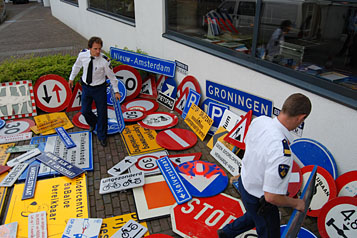 Last week I linked to a video by Mark Wagenbuur that showed what bicycle rush hour looks like at Utrecht Central Station. If you watched that video you may think that the Netherlands is a relatively car-free country, but the opposite is true (as anyone acquainted with Dutch traffic jams can attest).
Last week I linked to a video by Mark Wagenbuur that showed what bicycle rush hour looks like at Utrecht Central Station. If you watched that video you may think that the Netherlands is a relatively car-free country, but the opposite is true (as anyone acquainted with Dutch traffic jams can attest).
If you look at cars per square kilometre, The Netherlands, Japan and Belgium (in that order) lead the world by a wide margin. Not surprisingly, these three countries are both densely populated (skip the microstates for a second, and the Netherlands becomes the most densely populated country in the world) and fairly rich (positions 4, 14 and 19 respectively, again after discarding microstates).
If you look at the number of cars per household, the Netherlands is somewhere in the middle of the pack (400 cars per 1,000 people). Here, the US leads with 92% of the households owning a car (but in New York City less than 50% of households own a car).
It would seem that car ownership is both a function of income and available space and parking, but income is also a function of space, with high population density going hand in hand with low incomes.
Local governments try and find a balance between letting people own their cars and having a liveable environment. As we’ve reported before, some Dutch cities are trying to reduce the number of cars in the enviroment (others try to get rid of bicycles too) by cranking up parking fees.
What it means to be a country of car lovers is shown by the second entry of author John Scalzi’s list on Being Poor:
Being poor is having to keep buying $800 cars because they’re what you can afford, and then having the cars break down on you, because there’s not an $800 car in America that’s worth a damn.
In the Netherlands, if you own a car you are not poor, unless you live in your car. On the other hand, like in New York, plenty of well-to-do Dutch people do not own a car simply because they have no use for one.
In case this posting has just wet your appetite for more of Mark Wagenbuur’s mesmerizing videos, here is his latest:
(The video is of a road frequented by cyclists in Utrecht. Note the foreigner at 1.41. The photo is of the traffic jam in Zoetermeer, at around 6 pm. The traffic jam there starts around 4 pm.)

 A rotonde is a roundabout in Dutch, so when Tijs van den Boomen and Peter Jonker set out to create a website about roundabouts and the often ugly art that is in their centres, they of course called it
A rotonde is a roundabout in Dutch, so when Tijs van den Boomen and Peter Jonker set out to create a website about roundabouts and the often ugly art that is in their centres, they of course called it  No student house is complete without a traffic sign lifted without permission during a drunken late-night ramble. Or so I have heard.The Groningen police seem to think that
No student house is complete without a traffic sign lifted without permission during a drunken late-night ramble. Or so I have heard.The Groningen police seem to think that  Earlier this year, at age 62, traffic engineer Hans Monderman died of cancer. The
Earlier this year, at age 62, traffic engineer Hans Monderman died of cancer. The